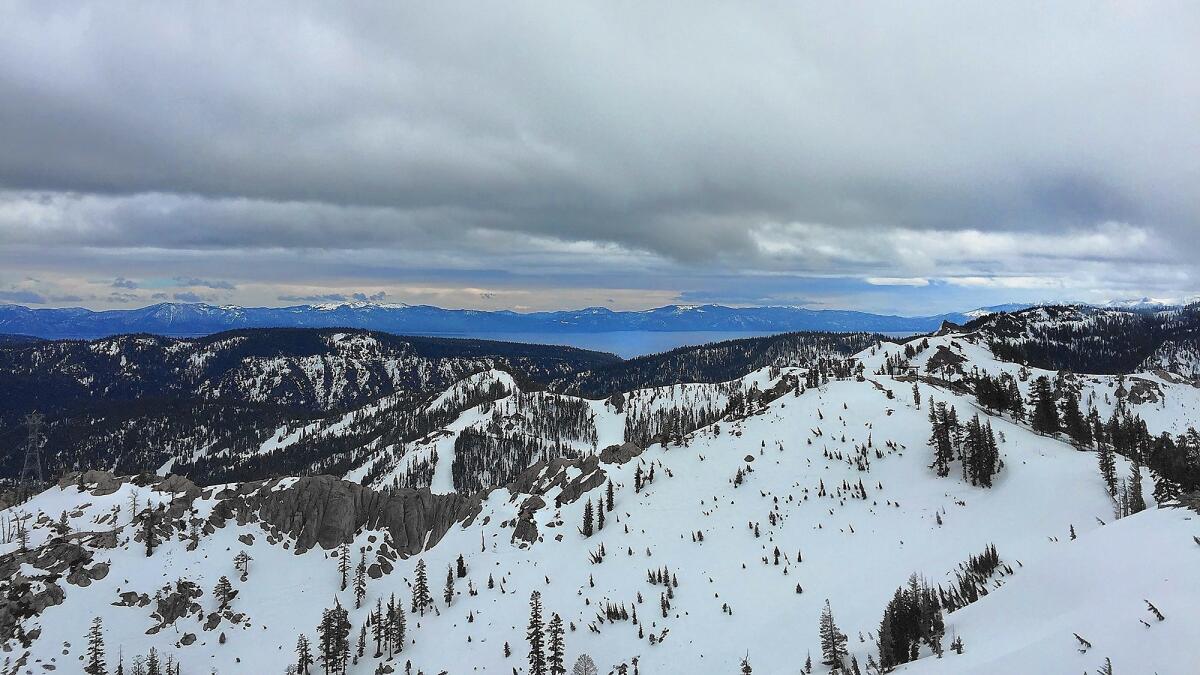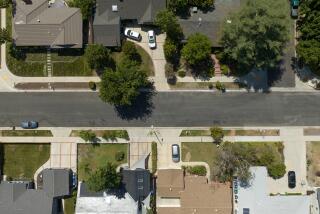State snowpack has changed a lot in the last year — as have Californians’ attitudes toward water

One year ago Friday, Frank Gehrke hiked out to Phillips Station and stuck a tube onto a tuft of brownish-green grass. There was no snow, but Gehrke had quite an audience.
A gaggle of reporters and even Gov. Jerry Brown had assembled at the outpost 90 miles from Sacramento to watch Gehrke work and bear witness to the severity of California’s drought.
What followed was a historic executive order from Brown that required a statewide 25% cut in urban water use and set in motion a fundamental rethinking about how Californians use the precious resource.
UPDATE: Sierra snowpack shows improvement, but not enough to declare California’s drought over
On Wednesday, when Gehrke hikes out to the field again, he’ll have something to measure. But the snow situation isn’t the only thing that’s changed in a year. Californians have largely risen to Brown’s challenge and begun to transform their relationship with water — even as they prepare for another hot, dry summer.
“It’s really important to recognize that people in California have done something extraordinary,” State Water Resources Control Board Chairwoman Felicia Marcus said when announcing that the state would come close to meeting Brown’s 25% mandate. “I think the governor will be very proud.”
All along, officials have emphasized the importance of capitalizing on the crisis to thrust California’s antiquated water policies and systems into the 21st century. The drought emergency has reminded many local agencies that relying on a single source of water can be risky, so they have expedited plans to diversify their portfolios.
Los Angeles is racing to cut its purchases of imported water in half by 2024 and has developed a “master plan” to capture more rainwater. The Metropolitan Water District of Southern California announced its intention to invest in a massive plant in Carson capable of turning sewage into drinkable water. And in the coming months, West Basin Municipal Water District is expected to release a report outlining plans for a desalination plant in El Segundo.
Meanwhile, a long-planned proposal to change the way water is transported through the Sacramento-San Joaquin delta is still undergoing a lengthy environmental review.
Water providers, including the Los Angeles Department of Water and Power, have revamped their rate structures to encourage conservation, even as they grapple with a controversial court ruling that dictates how they can calculate costs.
“It’s a modest start,” said Stephanie Pincetl, director of UCLA’s California Center for Sustainable Communities. “You can’t know in advance if there’s a sea change.... We just can’t give up.”
Brown’s April 1 order came after several previous actions meant to bolster the state’s water supply and blunt the drought’s effects. His initial call for Californians to voluntarily cut their water use by 20% had largely fallen on deaf ears. So, leveraging a barren field as his backdrop and a statewide snowpack that had plummeted to its lowest level in centuries, Brown unleashed the state’s first mandatory drought restrictions.
The 25% reduction in urban water use stood as one cornerstone of the executive order; a statewide initiative to replace 50 million square feet of lawn with drought-tolerant landscaping was another.
In February, state regulators announced that Californians had cut their water consumption by 24.8% over a span of eight months and saved more than 1.1 million acre-feet of water.
Thanks in part to a $340-million boost in turf rebate funding from the Metropolitan Water District, officials say the Southland alone removed 121 million square feet of turf from January 2014 to January 2016.
Meanwhile, state employees were working behind the scenes to update rules related to watering landscapes — another requirement of the executive order. In July, the California Water Commission approved changes that effectively limit how much grass can be planted outside new homes and all but ban grass in landscapes of new commercial, industrial and institutional buildings.
By June, Californians named water and drought as the most important issue facing the state, according to a survey by the Public Policy Institute of California. About 70% of adults said water supply in their part of the state was a “big problem.”
Although a survey this month showed fewer people still held those views, Mark Baldassare, president of the Public Policy Institute, said the issue has unusual “staying power.”
“A lot of people are still concerned,” he said. “This is an issue that a few years ago was not on people’s radars at all.”
Statewide conservation has slowed in recent months as Northern California has enjoyed El Niño-fueled rain and snow. But officials say the drought is not over.
“One year of average rainfall [will] not offset four years of record-breaking drought and heat,” said Gareth Lacy, a spokesman for Brown. “No one knows what the future will bring, and we must continue to prepare for the possibility of another dry year.”
In a nod to improved hydrology, Marcus’ water board approved modest changes to the state’s emergency drought that will allow suppliers to save slightly less water than they were previously required to.
The latest version of the regulation expires in October but could be modified after water board staff members analyze the state’s snow situation.
“Right now we’re at halftime, and we have a decent score on the board,” Marcus said in a recent interview. “We’re having a party for being barely average for this time of year in a couple of big reservoirs … but it’s not great.”
Experts say this drought — which Marcus likened to “the wake-up call of the century” — has been particularly punishing because it has been unusually hot. 2014 had the highest statewide average temperature in more than a century, state officials said. 2015 came in second.
The warming conditions have not been good for the snowpack, which usually reaches its peak around April 1, officials say. As temperatures warm, the snowpack melts and runs off into the state’s reservoirs, providing California with about 30% of its water.
On Tuesday the water content of the statewide snowpack stood at 87% of average for the day — far better than the 5% showing a year ago but still less that officials would like.
“Conditions aren’t suddenly flipped on their head when we get a little bit of rain,” said Doug Carlson, a spokesman for the Department of Water Resources. “The big picture is not rain.... The big picture is weather and climate. We most likely have lived into a new normal.”
Twitter: @ByMattStevens
ALSO
El Niño: Preparing now for disasters later
Dramatic before & after images: How El Niño transformed the California landscape
These scientists studying coral reefs were brought to tears -- but in a good way
More to Read
Sign up for Essential California
The most important California stories and recommendations in your inbox every morning.
You may occasionally receive promotional content from the Los Angeles Times.











